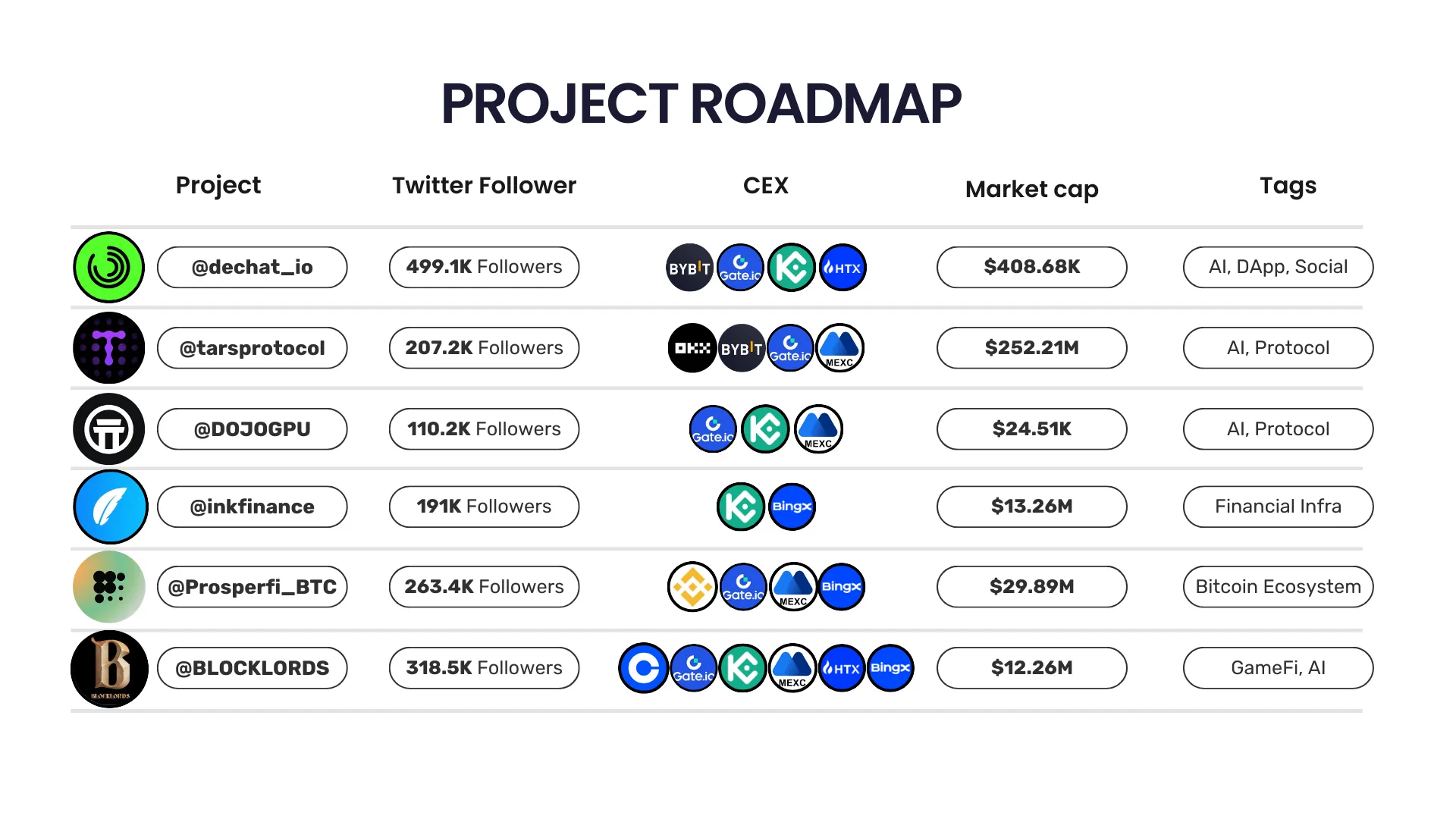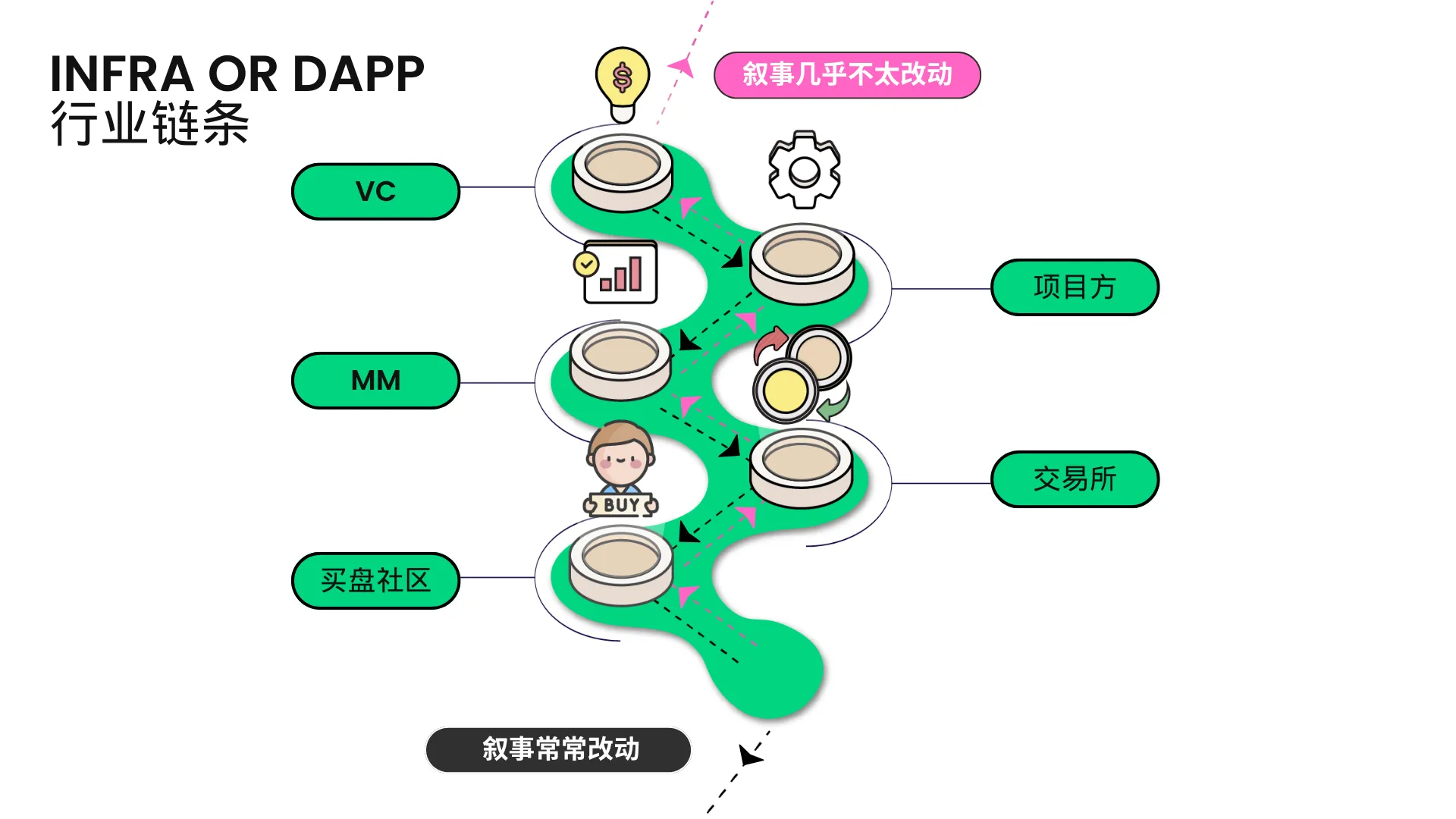If a truly phenomenal product that integrates Web3 and AI can emerge, it will genuinely achieve the fusion of Web2 and Web3.
Author: SunnyZ
Throughout 2024, starting from March, I have designed many marketing strategies for various projects' TGE, and almost every project has achieved user growth ranging from over 200k to 500k.
The projects are as follows:

We can see that the narratives of the projects are different, and the launches have been quite good (there are also some NDA projects that I cannot discuss for now), but from my perspective, the marketing strategies of these projects can be divided into two schools: top-down and bottom-up.
Industry Chain and Barriers

From the perspective of the industry chain in Web3, there are five types of participants: VC -> project parties -> MM -> exchanges -> buying communities. Each party here almost has its own barriers, and this trend is becoming increasingly evident. VCs generally do not know how projects grow, projects do not know how MMs operate, and buying communities do not know which tokens are good, only able to judge based on which exchanges the projects are listed on. Although I do not like VC coins, as the projects they invest in often run out of runway and rug pull, I must say that VCs have indeed brought prosperity to the industry, and the projects invested by Chinese VCs have supported a large number of utility DApps and games. I still believe that massive adoption relies on good games.
Many DApp projects, especially Chinese projects, have a very large user base, many followers on Twitter, and a robust community, but it is very difficult for them to get listed on good exchanges. Some projects that have issued tokens do not perform well in the market. I have observed that everyone is struggling this round, and some projects do not even know which MM is good, and buying communities cannot find them. This is completely opposite to projects like Infra, where the people involved are usually very active, often attending offline events and socializing, but this is actually very difficult to convert into useful resources, and I do not know what the significance is.
This sense of disconnection exists not only among project parties but also between domestic VCs and foreign VCs. I initially thought that domestic VCs would have the opportunity to battle with overseas VCs, but later found that there is not much real communication between the two sides; they are just forming cliques. The VCs that bet on DApps in the previous round have not seen returns as large as expected. If this round of the bull market and the imitation season is delayed beyond expectations, many projects will fall before dawn.
Different Project Marketing Strategies
This year, I worked on two L1 projects. Their marketing path was to first develop the product, find the MM (Market Maker) and buying communities, and set a narrative that would not change. Then, they discussed technical innovations and the project party's philosophy extensively on Twitter. Once the content accumulated to a certain extent, they opened a community and gradually shared their white papers and project materials in the TG Group. When the user base reached a certain level, such as ten thousand users, they would slowly start activities, giving airdrops to users who genuinely cared about them, and then seize the market opportunity to get listed. Many L1 projects even went to universities to give presentations and recruit, starting to educate users from the university level. Taking Grass as an example, although it is not L1, it can be considered an Infra type, and their marketing aligns very well with the aforementioned path. In 2023, the overall style of Grass's Twitter started off quite simple and natural, progressing gradually, actively creating memes to dominate user mindset. During that time, "Touch Grass" was frequently heard. Later, they gradually collaborated with a larger ecosystem (Solana), becoming much more professional. Since Blockwords introduced Grass, their entire Twitter traffic surged, with a key moment on December 2, 2023. After Blockwords' main account published an article, the traffic increased exponentially, while KOLs were also promoting it, and with the news of Grass's financing, the operation smoothly took off.
Of course, many projects that raised funds in two rounds did not last until the token issuance, and the money raised has been spent. Now, almost all projects are rebranding to associate themselves with AI. I have also noticed that most of the projects I know have changed their Twitter bios to narratives like "AI Powered." I must say that Chinese people are indeed very flexible; they latch onto whatever is popular [not meant derogatorily]. This, in turn, raises the marketing requirements, so joint campaigns have become a mainstream approach for many projects, being cost-effective and broad-reaching. However, the more activities are done, the more tokens are distributed in advance, and without real monetary airdrop activities, users do not participate, creating a paradox. And do the project parties that do not have enough concentrated tokens have sufficient pricing power to negotiate with exchanges? If they are only listed on Dex, naturally, the buying community is pitifully small.
Marketing Fusion of Web2 and Web3
Currently, the marketing strategies in Web3 are mainly social media growth, KOL promotions, partnerships between project parties, community-driven traffic, and BD attending events. The user growth achieved is limited and rather unremarkable. I actually feel that Web3 has reached a point where it should start doing Web2-style traffic investment, properly operating Reddit, Medium, TikTok accounts, Xiaohongshu, public accounts, and even video accounts, because people have social attributes, and algorithms will recommend users who follow Web3, Crypto, and AI-related topics. For example, the groups on Xiaohongshu that focus on Web3 are actually people who want to enter the industry but do not know how to start. These are the target buyers because one must first learn how to lose money before knowing how to make money; the market will educate users on its own. Therefore, many people are now using Xiaohongshu and investing in traffic on TikTok, and we can see that growth is gradually merging with Web2. If a truly phenomenal product that integrates Web3 and AI can emerge, it will genuinely achieve the fusion of Web2 and Web3.
Finally, regarding the Infra-type project marketing case mentioned above, I have attached the operational path of Grass for reference [each toggle list can be expanded].
https://www.notion.so/Research-for-Nebra-153e6b097b588089b93cd96f2283030b?pvs=4
Acknowledgments
Thanks to the stable project parties for providing information, and thanks to Deep Tide and MetaEra for their support of this article. Friends interested in Web3 marketing or growth are welcome to communicate more. My TG: @SunnyZ_Crypto [please forgive the slow replies to messages]
免责声明:本文章仅代表作者个人观点,不代表本平台的立场和观点。本文章仅供信息分享,不构成对任何人的任何投资建议。用户与作者之间的任何争议,与本平台无关。如网页中刊载的文章或图片涉及侵权,请提供相关的权利证明和身份证明发送邮件到support@aicoin.com,本平台相关工作人员将会进行核查。




